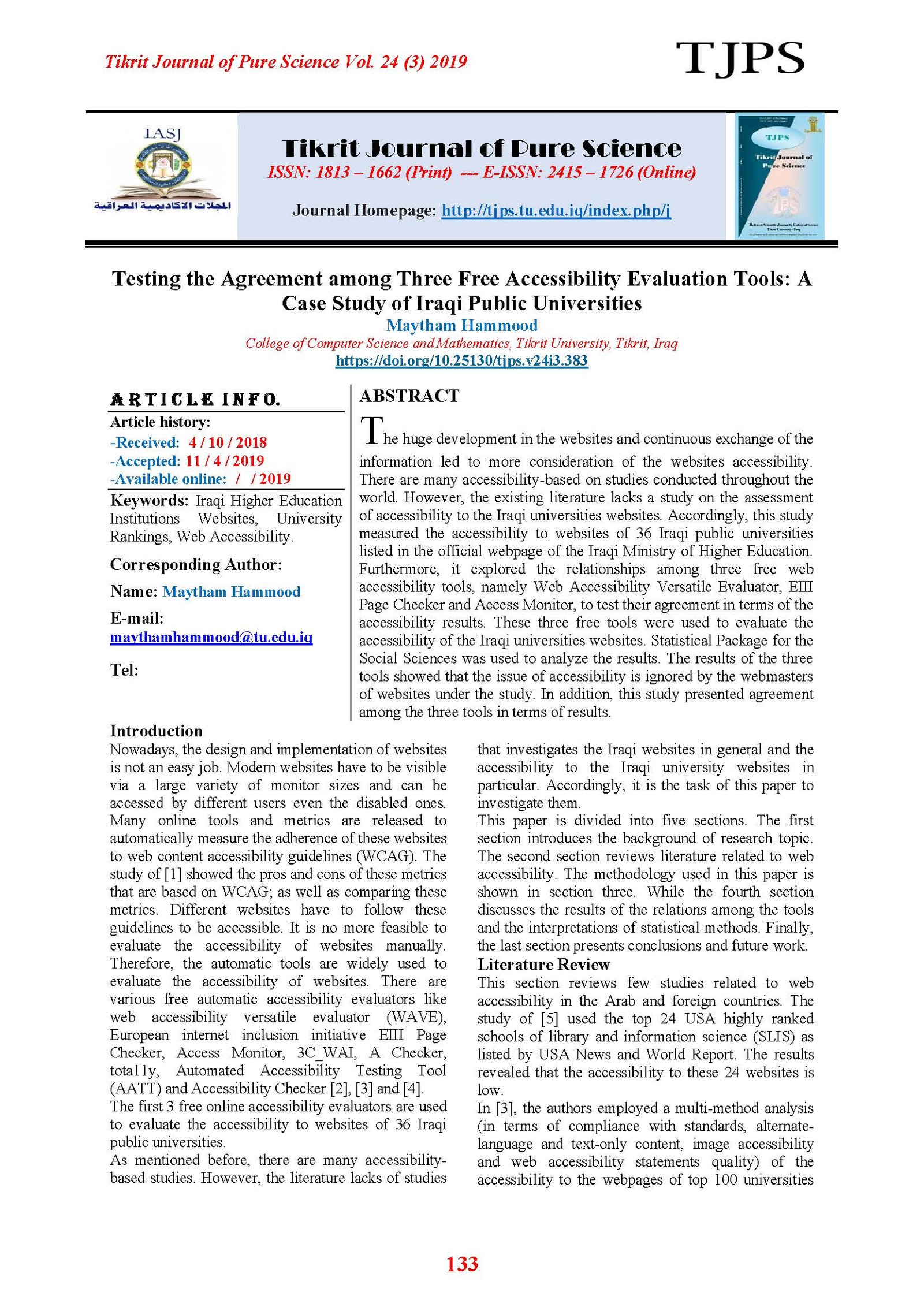Testing the Agreement among Three Free Accessibility Evaluation Tools: A Case Study of Iraqi Public Universities
Main Article Content
Abstract
The huge development in the websites and continuous exchange of the information led to more consideration of the websites accessibility. There are many accessibility-based on studies conducted throughout the world. However, the existing literature lacks a study on the assessment of accessibility to the Iraqi universities websites. Accordingly, this study measured the accessibility to websites of 36 Iraqi public universities listed in the official webpage of the Iraqi Ministry of Higher Education. Furthermore, it explored the relationships among three free web accessibility tools, namely Web Accessibility Versatile Evaluator, EIII Page Checker and Access Monitor, to test their agreement in terms of the accessibility results. These three free tools were used to evaluate the accessibility of the Iraqi universities websites. Statistical Package for the Social Sciences was used to analyze the results. The results of the three tools showed that the issue of accessibility is ignored by the webmasters of websites under the study. In addition, this study presented agreement among the three tools in terms of results
Article Details

This work is licensed under a Creative Commons Attribution 4.0 International License.
Tikrit Journal of Pure Science is licensed under the Creative Commons Attribution 4.0 International License, which allows users to copy, create extracts, abstracts, and new works from the article, alter and revise the article, and make commercial use of the article (including reuse and/or resale of the article by commercial entities), provided the user gives appropriate credit (with a link to the formal publication through the relevant DOI), provides a link to the license, indicates if changes were made, and the licensor is not represented as endorsing the use made of the work. The authors hold the copyright for their published work on the Tikrit J. Pure Sci. website, while Tikrit J. Pure Sci. is responsible for appreciate citation of their work, which is released under CC-BY-4.0, enabling the unrestricted use, distribution, and reproduction of an article in any medium, provided that the original work is properly cited.
References
[1] Freire, A. P., Fortes, R. P., Turine, M. A., & Paiva, D. (2008, September). An evaluation of web accessibility metrics based on their attributes. In Proceedings of the 26th annual ACM international conference on Design of communication (pp. 73-80). ACM. [2] Lilly, E. B., & Fleet, C. V. (2000). Wired but not connected: accessibility of academic library home pages. The Reference Librarian, 32(67-68), 5-28. [3] Kane, S. K., Shulman, J. A., Shockley, T. J., & Ladner, R. E. (2007, May). A web accessibility report card for top international university web sites. In Proceedings of the 2007 international cross-disciplinary conference on Web accessibility (W4A) (pp. 148-156). ACM.
[4] Petrie, H., & Kheir, O. (2007, April). The relationship between accessibility and usability of websites. In Proceedings of the SIGCHI conference on Human factors in computing systems(pp. 397-406). ACM..
[5] Schmetzke, A. (2001). Web accessibility at university libraries and library schools. Library hi tech, 19(1), 35-49.."
[6] Abanumy, A., Al-Badi, A., & Mayhew, P. (2005). e-Government website accessibility: in-depth evaluation of Saudi Arabia and Oman. The Electronic Journal of e-government, 3(3), 99-106..
[7] Al-Khalifa, H. S. (2012). The accessibility of Saudi Arabia government web sites: an exploratory study. Universal Access in the Information Society, 11(2), 201-210.
[8] Xanthidis, D., & Violettas, G. (2016). Security, Privacy, Accessibility and Availability issues addressed when developing websties in the GCC. Journal of Theoretical & Applied Information Technology, 88(2).
[9] Akram, M., & Sulaiman, R. B. (2017). A Systematic Literature Review to Determine the web Accessibility Issues in Saudi Arabian University and Government websites for Disable People. methodology, 8(6).
[10] Al-Khalifa, H. S., Baazeem, I., & Alamer, R. (2017). Revisiting the accessibility of Saudi Arabia government websites. Universal Access in the Information Society, 16(4), 1027-1039. [11] Al-Soud, A. R., & Nakata, K. (2010, December). Evaluating e-government websites in Jordan: Accessibility, usability, transparency and responsiveness. In Progress in Informatics and Computing (PIC), 2010 IEEE International Conference on(Vol. 2, pp. 761-765). IEEE. [12] Al-Radaideh, M., Nuser, M., & Wahbeh, A. (2011, May). Evaluating accessibility of jordanian e-government websites for people with disabilities. In Proceedings of International Conference on Information and Communication Systems (pp. 22-24).
[13] Nizar, A. A., Obedidat, A., & Abu-Addose, H. Y. (2013, May). Accessibility as an indicator of Jordanian E-government website quality. In e-Learning" Best Practices in Management, Design and Development of e-Courses: Standards of Excellence and Creativity", 2013 Fourth International Conference on (pp. 156-160). IEEE.
[14] Abu-Doush, I., Bany-Mohammed, A., Ali, E., & Al-Betar, M. A. (2013). Towards a more accessible e-government in Jordan: an evaluation study of visually impaired users and web developers. Behaviour & Information Technology, 32(3), 273-293.
[15] Al-Kabi, M. N. (2018). Exploring the relationships between web accessibility, web traffic, and university rankings: a case study of Jordanian universities. International Journal of High Performance Computing and Networking, 12(3), 235-250.
[16] AlKaabi, R., Ali, H. and Yasser, M. (2015). E-Government websites Accessibility for People with Disabilities (PWD): In Depth Evaluation of Kingdom of Bahrain, Int. J. Comput. Inf. Eng., vol. 9, no. 5.
[17] AlBalushi, T., Ali, S., Ashrafi, R., & AlBalushi, S. (2016). Accessibility and Performance Evaluation of E-Services in Oman Using web Diagnostic Tools. International Journal of u-and e-Service, Science and Technology, 9(7), 9-24.
[18] Saleem, M. (2016). web accessibility compliance for e-Government websites in the Gulf region. Edith Cowan University
Retrieved from https://ro.ecu.edu.au/theses/1916 .
[19]http://checkers.eiii.eu/en/pagecheck2.0/?uuid=f45c9f1e-3157-48aa-9421-601c59bafc35
